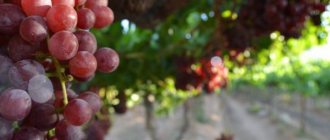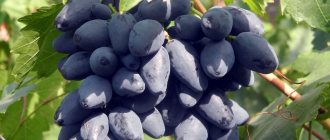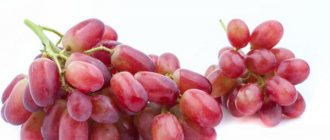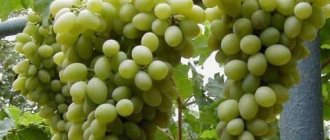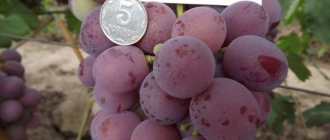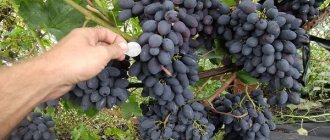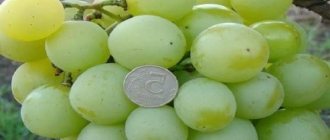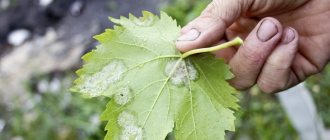The hybrid form “White Giant” appeared in winegrowing farms not so long ago, less than ten years ago. This is a hybrid selected by Vasily Ulyanovich Kapelyushny, who, by crossing “Talisman” and “Radiant Kishmish”, received a new stable large-fruited form. The most detailed description of the grapes and all its characteristics can be found in this article.
How to choose grape varieties
There is no ideal variety or hybrid form, so consumers are forced to look for specimens for themselves, guided by their own criteria and ambitions.
There are a great many varieties and hybrid forms of culture, but even experienced winegrowers cannot always navigate this diversity. Particular attention is usually paid to the emergence of hybrids, which often turn out to be more adapted to unfavorable conditions and resistant to diseases.
Thus, thanks to the painstaking work of breeders, improved Krasokhina and Krainova grape varieties were created for the Moscow region and middle regions of the Russian Federation. Some have large berries, but do not bear fruit very abundantly, while others, with smaller berries, produce excellent harvests. The catalog of new grape varieties in alphabetical order, located below, will help amateurs choose the best option for growing in a particular region of the country.
The main mistakes gardeners make when caring for late varieties
- Gardeners often forget that it is necessary to prune late varieties, otherwise the berries will be very small and the bush will begin to grow greatly.
- Another mistake gardeners make in growing late varieties is completely removing the cover in the spring. This should not be done, otherwise the bushes will begin to weaken.
- For some reason, many gardeners believe that when the berries of late varieties are full, they need to be watered abundantly. But it is undesirable to do this, otherwise the berries will begin to crack and die.
Such different A-grades
Augustine
Augustine table grapes with decent quality characteristics are distinguished by reliability, unpretentiousness, and high yields of up to 120 centners per hectare. The bush is frost-resistant (down to -24 °C), has immunity against mildew, as well as rot and oidium. Augustine (or scientifically Pleven) is a godsend for beginners; it is grown without shelter and, due to its vigorous growth, is used as an arbor crop.
Conical clusters usually do not exceed 500-750 grams, but on “fat” soils, with sufficient nutrition, they can reach a kilogram. Large, oval berries are not located too densely, each weighs about 6-8 grams. Pleven's taste is simple but harmonious. The translucent, white bunches look very presentable and beautiful; they can hang on the bushes without spoiling for about 3 weeks.
Amursky
Deciduous Amur grapes come from the Far Eastern taiga, China, and Korea and are the most frost-resistant and hardy species. The dioecious plant is characterized by strong growth, annual abundant fruiting, and unpretentiousness. The highest quality harvest can be obtained in a well-lit area. It usually ripens in mid-September.
Round berries in loose clusters of cylindrical or conical shape. On different bushes, the fruits have different tastes from sour to pleasantly sweet. Purple or black with a bluish tinge, the berries are quite juicy, with a thick skin. The weight of the bunches is usually about 50-70 grams, sometimes reaching 250.
Anyuta
The parents of the Anyuta grape are the Kishmish radiant and Talisman varieties, crossed by amateur breeder Krainov. The hybrid form is not afraid of mildew, oidium when treated with fungicides, as well as frosts down to -23 ° C. Anyuta is optimally suited for beginning winegrowers due to its vitality and excellent rooting ability. The first fruits can be obtained after four years; they ripen in 140 days.
A vigorous bush is characterized by large clusters of a not very regular conical shape, weighing about 700-1200 grams. With favorable care, medium-dense clusters with beautiful glossy berries can grow up to 1.5 kg. The fleshy berries have a dense but delicate skin, weigh about 20 grams, and have a delicate nutmeg aroma.
Arcadia
Arcadia is a fairly popular early table variety. Among its advantages are a powerful root system, good rooting, record high yield, immunity to rot, mildew, excellent transportability, elegant clusters, beautiful, tasty berries. Disadvantages include a tendency to overload with crops, cracking, and the need for protection from oidium. According to reviews from winegrowers, Arkady, or popularly Nastya, is unstable in the middle zone due to uneven ripening of the vines.
The ripening period is approximately 115 days, the clusters have a dense, branched structure and weigh on average 700 grams, although there are specimens up to one and a half to two kilograms. The berries are white or amber-yellow in color, have fleshy pulp and durable, thin skin, each weighing 8-15 grams. Arcadia has a simple, harmonious taste, with a delicate nutmeg aroma.
Answers to frequently asked questions
Question No. 1. At the end of summer, Isabella's one-year-old seedling began to sprout with two shoots. Should they be removed or is it better to form two new sleeves from them?
Such young seedlings have a weak root system, so you cannot leave more than one sprout, otherwise they may simply die.
Question No. 2. When the vine first opened in the spring, its young bushes looked normal, but after a couple of weeks they began to turn black and die. What went wrong?
I think the problem is in the eyes: they are probably frozen or faded. Trim the dead vine back to a “living” one, and then form bush sleeves using new growth for this purpose.
Question No. 3. For the second year in a row, as soon as spring comes, the vine turns black. I used foliage to cover the bushes in winter. Maybe the leaves are to blame?
Yes you are right. Winter thaws wet the foliage, and because of this, the vine withered and died. For winter shelter, use only something “dry” and not wet. Reed mats are fine. Wooden boxes also protect vines well from excess moisture and cold.
Question No. 4. I decided to plant a cutting with a sprout of the Merlot variety. He took it and died. What's my mistake?
Perhaps the cuttings did not have time to form roots. As for the sprout, it was “given birth” by plastic substances that accumulated in the cutting. To prevent this from happening again, you need to “furrow” the bark at the bottom of the cutting, and then dip it in a heteroauxin solution for 2-3 hours. This will help root formation.
Question No. 5. I covered my late vine bush with plastic wrap for the winter, but in the spring it turned black and died. Is he frozen?
I think it's wrong. After all, grapes are not “friendly” with plastic film. To use it simply means to destroy the vine: it will wither under it during the winter thaw. It is better to cover the vine with several layers of spruce branches. Wooden boxes or even boards are also suitable.
“Victoria is delighted” or the most interesting varieties in terms of frost resistance
Victoria
Victoria grapes are successfully grown in the northern regions, thanks to the ripening period of 120 days, as well as excellent yield. Weak bushes need pollinating varieties that bloom at the same time. The shoots ripen well and tolerate frosts down to -27 °C. The hybrid form has increased immunity against oidium, rot, and mildew.
Large clusters of conical shape, not too dense in nature, are loose. Their weight varies from 500 to 700 grams, but the brushes from the lower part of the bush do not reach such figures. The red-raspberry berries are very fragrant, have a special nutmeg taste, and weigh mainly 6-7 grams. Unfortunately, it is these fruits that wasps love to feast on, and they get most of the harvest.
Delight
The Vostorg grapes, like Arcadia, are always reliable - productive, tasty, frost-resistant, disease-resistant. A special feature of the variety is the direct dependence of the ripening period on the load: with a weak load it is very early, with a good load it can become medium-early. Looks great on gazebos and awnings in the yard.
Ripe clusters of conical or branched shape have a dense structure, their weight can reach one and a half kilograms. The weight of each oval berry is within 6-7 grams; the core is juicy, crispy, and the skin, although dense, is easy to chew. Large amber-white berries acquire a golden tan in the sun. In addition, Delight tends to accumulate increased doses of sugar up to 26%.
Description of the White Giant variety
As stated above, the name “Tuzlovsky giant” was given to it for a reason, because it has large clusters with an elongated shape and round berries of the same size. The description of the fruits boils down to the fact that the berries of this variety are quite large, they can be compared to a 5 ruble coin, and each berry weighs about 10 grams. The berry itself is juicy and fleshy; there are 4 grains located in the center of the fruit. The leaves of the White Giant are large and medium in size, dissected and five-lobed. Bushes of medium vigor, in rare cases require shaping. With good care it will give you a wonderful harvest. Tuzlovsky is a medium-ripe grape variety: the ripening period can range from 115 to 125 days at a temperature of 25 degrees. On average, per season it produces a large harvest of about 8 kilograms per bush.
This variety is worthy of your attention. After all, it has a number of advantages over other varieties:
- early maturation;
- this variety has a beautiful appearance, it is impossible not to pay attention to it;
- easy to transport;
- cultivation and care will not be difficult for you;
- The “White Giant” has the so-called immunity to mildew, phylloxera and oidium, and even if it gets sick, it can easily cope with such diseases.
- "Giant" grapes are frost-resistant.
Three famous "K"s
Cardinal
The attitude towards the Cardinal grape is quite ambiguous: some scold it and want to get rid of it as quickly as possible, while others will not exchange it for any other variety. With excellent yield, high taste, and beautiful appearance, it is unusually capricious and unstable. However, with a certain approach, it is almost always possible to obtain large, marketable brushes.
The bushes are characterized by medium and vigorous growth and can be severely affected by leaf rollers, oidium, mildew, and rot. As perennial wood increases, yields increase. The fruits are used fresh, for preservation (jam, compotes). The harvest is harvested selectively, as the bunches ripen unevenly. Cardinal is grown exclusively in warm areas, because the plant is very sensitive to low temperatures.
Huge, oval berries (18 g) are purple-red in color. Their crispy flesh is juicy, meaty with a pleasant nutmeg aftertaste, the peel is easy to tear. The clusters are formed cylindrical-conical, with varying degrees of looseness. The average weight of a twig is 600-800 grams, some - 1.5 kg. The cardinal tolerates transportation conditions well and ripens by the end of August.
Kesha
Kesha grapes are also called FV-6-6, Super Kesha, Talisman, Kesha Muscat, Improved Delight. Vigorous bushes with powerful roots bear fruit well, but tend to be overloaded with harvest. The clusters are usually very large, dense, often conical or shapeless, and weigh between 900-1100 grams. The variety is in high demand on the market and is in good demand.
Quite large fruits weigh on average 12 grams and contain no more than 3 seeds. The oval berries are white in color, have dense pulp, and a harmonious taste. Kesha is characterized by the ability to accumulate a lot of sugars - up to 24%. In addition, among the advantages are increased resistance to mildew and frost resistance.
Codrianca
The very early grape Codrianca is a complex hybrid of Moldavian selection with very large berries. Vigorous bushes are not afraid of frosts of -24 ° C, and are characterized by increased resistance to gray rot and mildew. The advantages of Kodryanka are high yield, good transportability, ripening at 110 days.
The weight of massive conical bunches reaches up to 600 grams, but can also be up to one and a half kilograms. Large purple fruits, 6-8 grams each, have a pleasant, simple taste. Their flesh is crispy, juicy, and the seeds are easy to separate. Kodryanka branches can hang on the bush for about three weeks without losing their taste. In dry weather it may pea.
From Libya to Sofia
Libya
The hybrid form of Libya grapes is characterized by stable fruiting, excellent taste with a muscat smell, very early ripening of fruits on the 105th day, frost resistance down to -21 oC, good resistance to oidium and mildew. Large cylindrical and branched brushes have a medium-loose structure and grow up to 35 cm in length.
Pink berries with fleshy, juicy pulp and delicate thin skin contain no more than three easily separated seeds. The fruits can be oval or ovoid, weighing about 13 grams. The mass of beautiful bunches of marketable appearance is 700-1000 grams, although there are specimens weighing 1.2 kg. The disadvantage is that the berries are not always fully colored according to the declared color.
Lydia
Other names for the universal grape Lydia are Isabella red and pink, Lydia pink. This tableware variety belongs to the isabella group and is often used for the preparation of fortified and dessert wine materials, as well as grape juice. In addition, Lydia is ideal for decorating gazebos, pergolas, canopies, and alleys. Resistant to diseases: oidium, mildew.
Small loose, less often dense, clusters are almost always conical in shape, their weight ranges from 60 to 100 grams. The medium-sized berries are dark pink in color with a waxy coating on a dense skin and have a specific strawberry aroma. The high yield of the variety ensures the production of 40 kg of fruit from one plant. In the south, Lydia is not sheltered.
Laura
The extra-early Laura grapes were bred by breeders from the Odessa Institute; among its positive characteristics are ripening in 110 days, harmonious taste, good yield, beautiful presentation, excellent transportability, immunity to gray rot, mildew, and cracking of berries.
Massive conical or branched branches usually have a moderately dense structure, but are occasionally loose. Large oval white berries with a tanned side form large clusters of 700-1500 g. The dense pulp of the fruit with small seeds has the ability to accumulate high sugars (more than 20%). The harvest is excellently stored on the bushes.
Sofia
The first-class early grape Sofia captivates with its gigantic cluster sizes weighing up to 2 kg and the bright muscat, delicately sweet taste of the same large berries. Due to the plant’s good receptivity to “wandering pollen”, dense conical clusters are formed on the bushes, and there is no pea formation. The variety has excellent resistance to mildew and tolerates frosts of -21 °C.
The berries are ovoid, elongated-conical in shape and weigh between 10-16 grams. The light aroma of nutmeg, fleshy-juicy pulp, tender skin, and the presence of 1-2 seeds puts Sofia on the same level as the best varieties. It is worth noting minor drawbacks - average transportability, the tendency of the berries to fall off when overripe.
Characteristics of the Lydia species
It is a universal varietal variety. Lydia Pink has a second name; the names may appear in the literature in different layouts, but denote one variety. Planting is carried out in autumn and spring. The fruits ripen in August. The period lasts 150 days. The grapes are highly productive; the berries have a slimy pulp with a strawberry flavor. The taste of the fruit only improves if it sits for a while. Before planting, the bushes must be soaked for a day and then planted in the ground. Before the winter period, the plant must be sprayed with Bordeaux substance; it can overwinter without shelter. It is worth pruning and avoiding excessive density. Grape bushes love excessive watering.
Hadji Murat
The Hadji Murat grape hybrid from breeders from Tajikistan is a mid-early variety, its fruits ripen in 125 days. Vigorous bushes form elegant, very large clusters weighing over a kilogram, which are in extremely high demand among market buyers. With sensitive care, clusters of more than 3 kg are not uncommon.
Hadji Murat's taste is pleasant and harmonious. Berries with crispy, juicy, dense pulp can weigh more than 20 grams, with only 1-2 seeds. Black, waxy fruits have an oblong, almost cylindrical shape. Brushes are most often shapeless, conical, with a loose structure. The advantages include excellent transportability, shelf life, relative frost resistance (down to -21 °C), and consistently high yield.
Anniversary of Novocherkassk
The interspecific hybrid Jubilee of Novocherkassk is one of the famous trio of breeder V.N. Krainov, consisting of very similar hybrid forms Victor and Preobrazhenie. On vigorous bushes, conical, cylindrical-conical branches of medium density are formed, the weight of which depends on care and can vary from 800 g to 3 kg. The Novocherkassk Jubilee grapes ripen in 110 days and are not prone to peas.
Large, elongated oval fruits of 15-18 grams each can be pink, white-pink, or yellow-pink. The berries have a harmonious taste, medium-dense pulp of a fleshy-juicy consistency, and a medium-thick skin that is not felt when eating. The advantages of Jubilee Novocherkassk are good ripening of shoots, transportability, stable high yield, immunity to fungal diseases.

